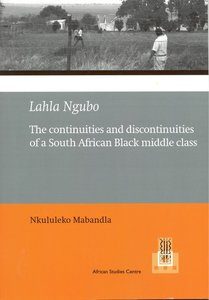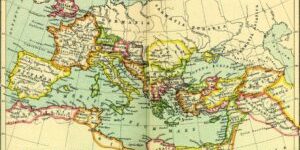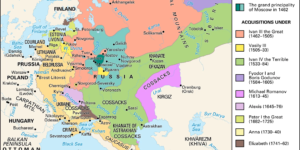Nkululeko Mabandla ~ Lahla Ngubo – The Continuities And Discontinuities Of A South African Black Middle Class
No Comments yet Introduction and contextual background. [This book is the winner of the Africa Thesis Award 2012]
Introduction and contextual background. [This book is the winner of the Africa Thesis Award 2012]
This work explores the role of land in Mthatha’s Black [Black is used in this thesis to refer to ‘Black African’] middle class during the apartheid and democratic eras. Mthatha’s Black middle class, which developed at the turn of the twentieth century, is a particular type of middle class that is defined not only by occupation but also by ownership of land. The path to land came about when the Mthatha municipality auctioned land to both Black and white buyers in 1908. This allowed the accumulation of land in the hands of a hitherto occupation based, mission educated Black middle class. The study traces the development of this class from the mid nineteenth century to the democratic era, and focuses on how this middle class reproduced and transformed itself during this time.
The study builds on Redding’s (1987) historical study of Mthatha (1870-1950). In addition to the first generation discussed by Redding, this study identified two more generations: A second generation which developed from the 1950s onwards, and their descendants, the third generation, which continues to combine occupation and landownership to date.
The role of land in the definition of the Black middle class is sorely missing from studies of this class in the democratic period. Recent studies have drawn attention to the growth of this class in post-apartheid South Africa. This growth was supported by employment policies such as affirmative action (AA) and Black economic empowerment (BEE). Studies have generally focussed on income/occupation as the main determinants of middle class location (e.g., Udjo 2008; Unilever Institute 2007; Rivero et al. 2003). Thus, Rivero et al. (2003) analyse the advances made by Black South Africans in the managerial and professional categories between 1994 and 2000. Their sole criterion for identifying membership in the Black middle class is occupation. Meanwhile, Unilever’s much publicised ‘Black Diamond Study’ (Unilever Institute 2007) deals almost exclusively with consumption patterns of Black professionals, that is, their affluence based on income. And indeed, much interest has been generated in the popular press, where the Black middle class is often portrayed as ‘young and driving a BMW’ (Carrol 2004).
While the new Black middle class might have considerable disposable income, it seems to lack investment in more durable assets such as property. Studies of residential mobility suggest that home ownership, for example, remains relatively low within the ‘new’ Black middle class (Beavon 2000; Prinsloo & Cloete 2002; Crankshaw 2008). The general absence of property within this class has led Southall (2005: 1) to compare it with the proletariat:
The ‘new middle class’, which is typically in government and corporate employment, shares many of the characteristics of the classic proletarian, notably in the sense that it has no direct ownership of the means of production and is in a subordinate relationship to capital owning employers.
The conceptualisation of the Black middle class by income/occupation only is not a recent development. For example, Crankshaw (1997; see also Seekings & Nattrass 2006) looks at the Black middle class in pre-1994 South Africa through the occupation lens (see Chapter 2 for a detailed discussion).
The dominant narrative of South African social history in the twentieth century is that of a massive reconfiguration of social relations as a result of the discovery of minerals in the late nineteenth century. African land dispossession became necessary to serve the labour demands of the developing mining industry and the white commercial farming sector (Feinstein 2005: 33). According to Domar (1970, cited in Feinstein 2005: 33), land can become a problem for capitalist production when it is plentiful because peasants prefer to work their own land as independent producers rather than as hired labour. To attract them, employers would have to pay wages that would be comparable to what they could earn as independent farmers. In the history of South Africa, legislative measures such as the Glen Grey Act of 1894 and the Natives Land Act of 1913 facilitated Black land dispossession (see Chapter 2 for a detailed discussion).
Large-scale dispossessions notwithstanding, Jordan (1984; also Peires 1989: 329) informs us of a long-standing and well-established landed Black middle class in South Africa. Evidence of an early Black landowning class that was buying up land in the late nineteenth century can be found in Murray’s (1992) work on Thaba Nchu. A class of entrepreneurs who were both transport riders and/or land controllers (if not owners) was also identified by Bundy in his study of the nineteenth century peasantry (Bundy 1988). Murray and Bundy demonstrate that land was important in creating affluence and allowing for education. This, in turn, facilitated salaried white-collar employment.
Thus, in addition to land, education played an important role in structuring class differences, and mission education introduced new forms of skill-based stratification as Black land dispossession intensified. The division of Black society along lines of western Christianity and mission-education on the one side, and African traditional belief systems on the other, became ever more marked as the colonial modernizing project gained momentum. In the Eastern Cape region of South Africa (where this study is located; see section on methodology), for example, social differentiation among the amaXhosa took the form of an emerging dichotomy between ‘school’ people and ‘red’ people. The former were also called amagqobhoka (literally ‘the penetrable ones’), meaning those who had adopted western norms of behaviour; the latter were referred to as ‘red’, or amaqaba (literally ‘the smeared ones’) because of the red ochre which they used as traditional (form of) make-up. The ‘school’ people, distinguished in the popular imagination by exposure to western education as well as European tastes, formed the nucleus of the emerging middle class (see e.g. Mayer 1961; Gerhart 1978).
However, the combination of wars in late nineteenth century as well as legislative measures such as the Glen Grey Act of 1894 and the Natives Land Act of 1913 are largely believed to have separated many Africans from land and driven large numbers into proletarianisation. Consequently, the growth of the urban industrial sector from the first half of the twentieth and the economic boom of the 1960s is understood have provided occupational opportunities, especially for the educated and skilled. These developments gave rise to an urban based middle class – the focus of most existing sociological studies – that was solely defined by occupation and the advent of democracy opened even more occupational advancement channels for this class. Thus land, in the view of many studies, became insignificant in the definition of this class.
This book challenges such approaches and argues that a full understanding of the middle class needs to pay due attention to property ownership (or lack thereof). Moreover, it is vital to adopt a historical perspective and move beyond the present conceptualisations of this class. While those who joined the Black middle class post-1994 as a result of new government-driven opportunities might indeed be property-less, many of those who come from longstanding middle class families – with origins reaching back to the nineteenth century – have more than marketable professional qualifications, they typically also have access to land.
This study contributes to our understanding of the trajectories South Africa’s historical Black middle class – a class which is defined by access to (mission school) education, and resulting occupational opportunities, as well as access to land. The ways in which this particular landed middle class has reproduced and transformed itself from 1900 to the present is the focus of the analysis. In many cases it was returns from land which made education possible in the first place, and the relatively high salaries obtained from white-collar and professional work allowed re-investments in land. Education and landownership thus co-existed in a cyclical and mutually reinforcing relationship.
Thus, this book argues that the question of Black landownership needs to be looked at inter-generationally. Newman (1993), for example, shows that class is a question of historical continuities and is transmitted through kinship ties, in other words, it shows a ‘family trajectory’. The middle class under study is a particular Black middle-class that established itself in Mthatha in the former Transkei Bantustan. In contrast to other Bantustan towns, Mthatha was a welldeveloped town, a thriving commercial centre which offered opportunities for employment and property ownership. Mthatha also had significant white commercial interests and was thus prescribed as a ‘European town’ at least until the 1960s (Horrell 1971). Thus, the development of an ‘urban’ landed Black middle class in a major ‘white spot’ such as the town of Mthatha, presents an interesting case study for the understanding of the role of land in the definition of the Black middle class.
Download the book (PDF): https://openaccess.leidenuniv.nl/ASC-075287668-3311-01.pdf?sequence=2
Comments
Leave a Reply








